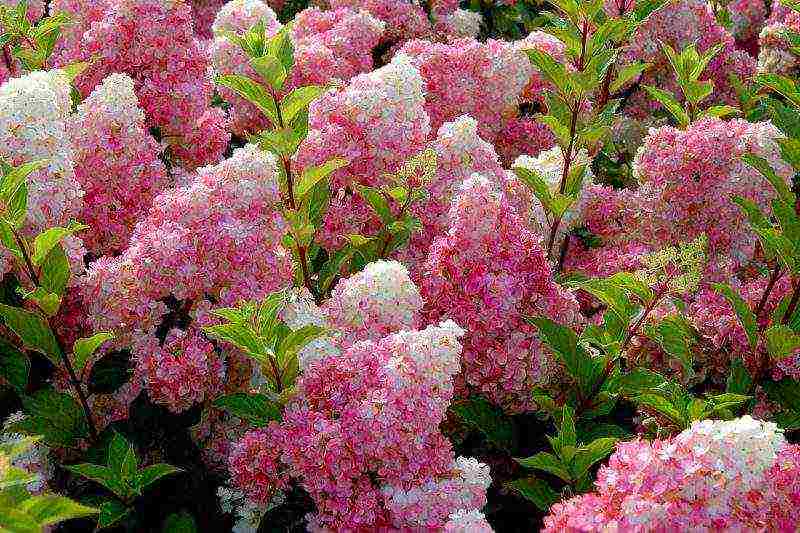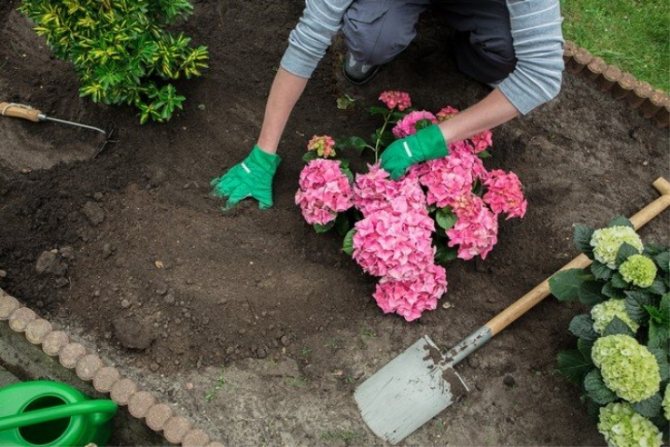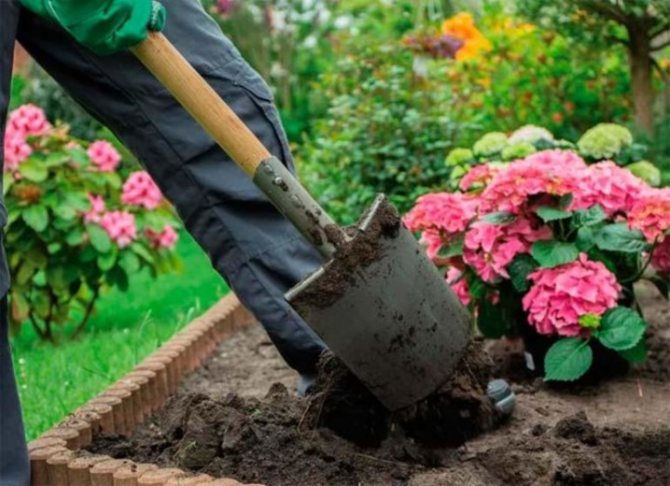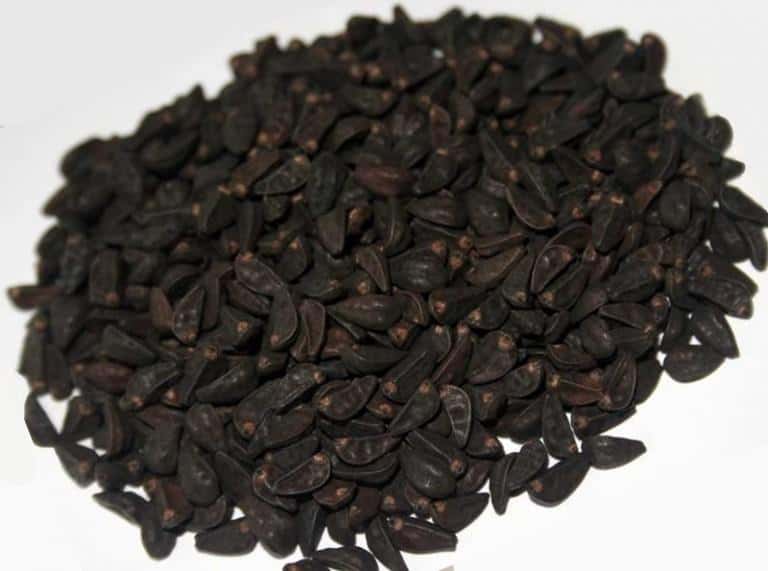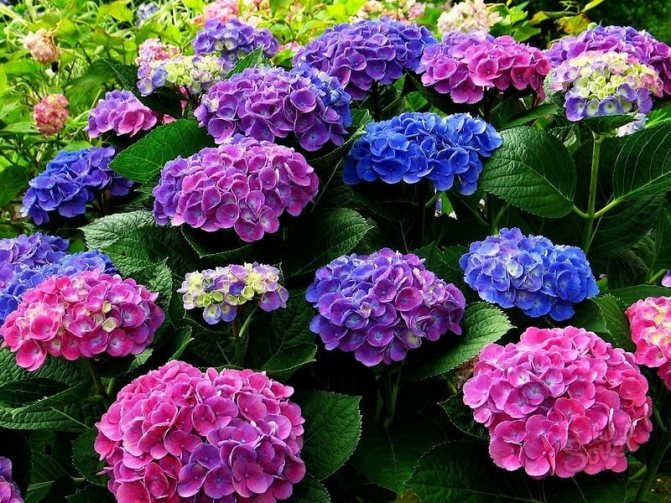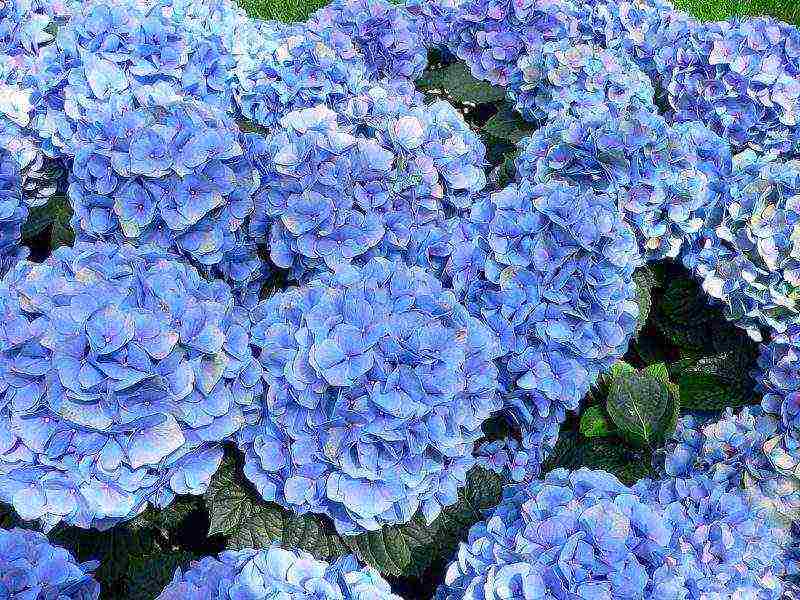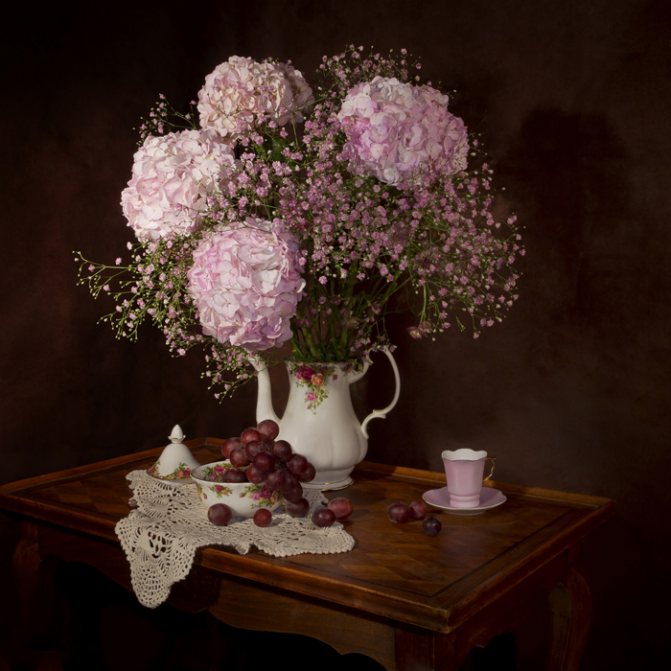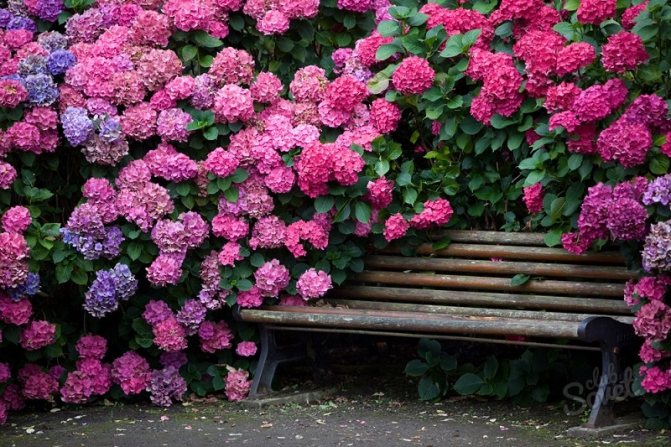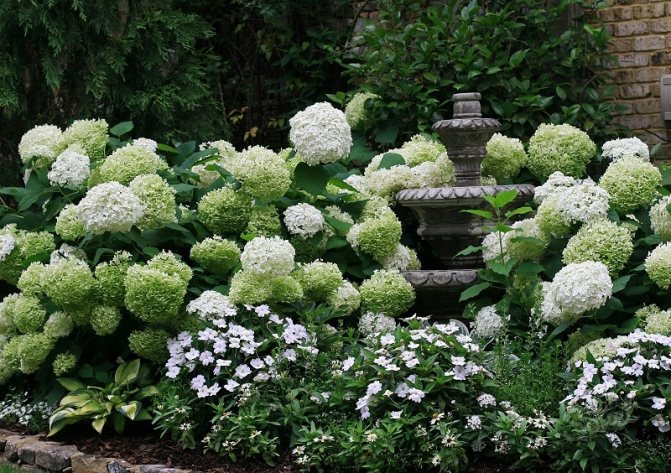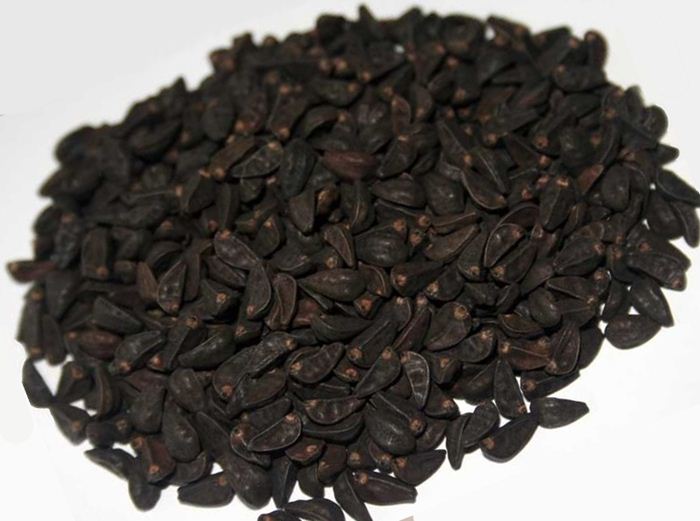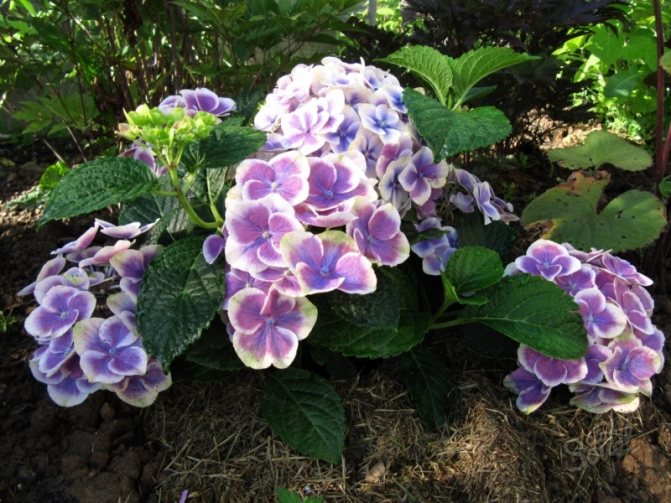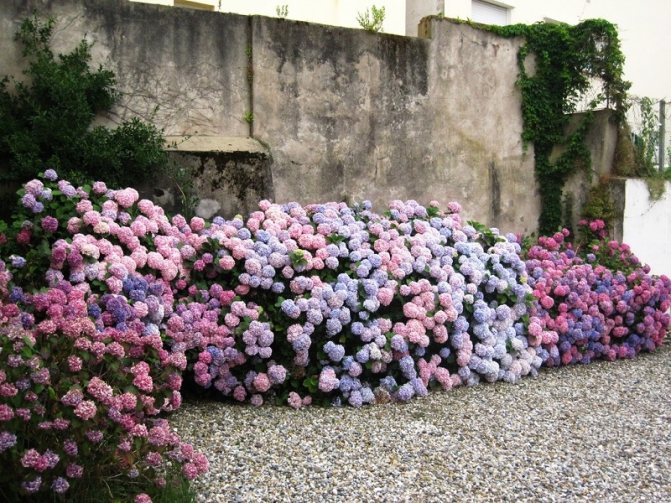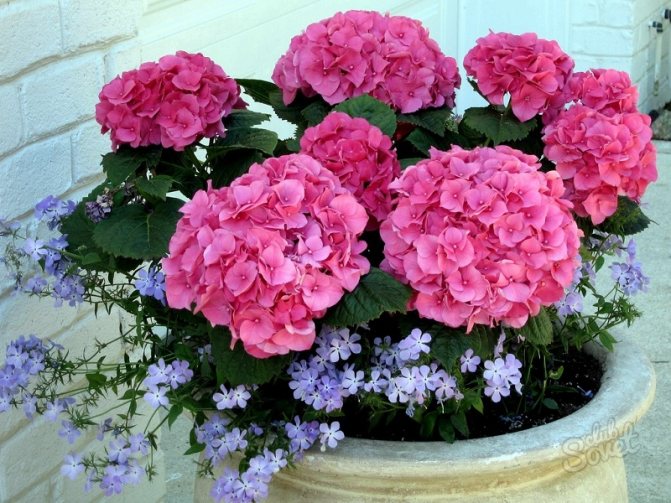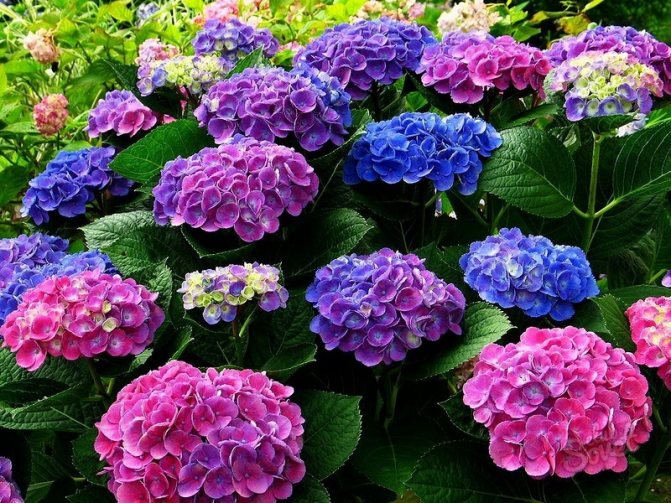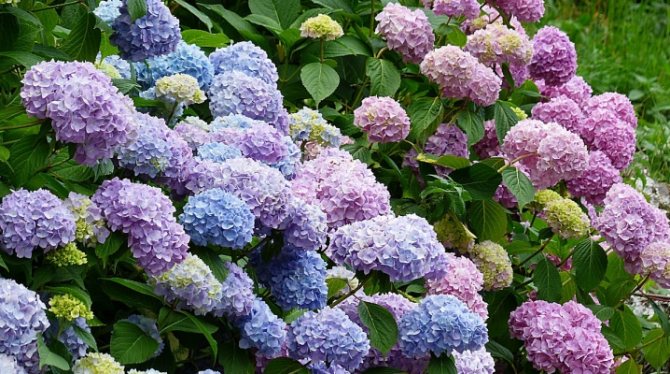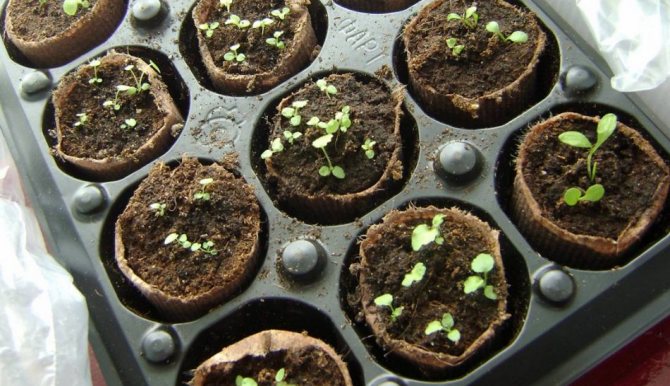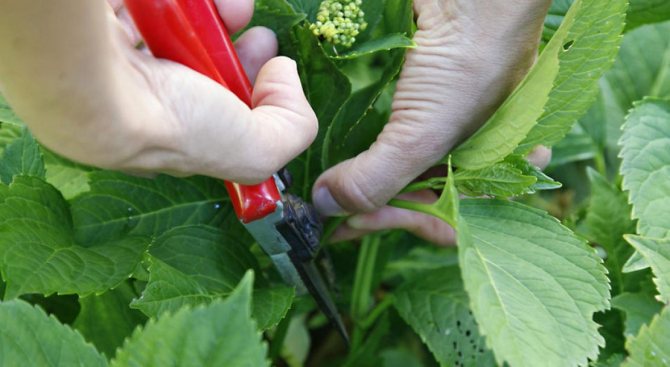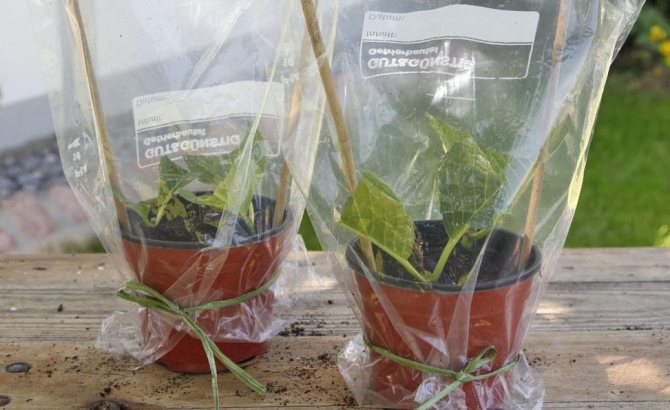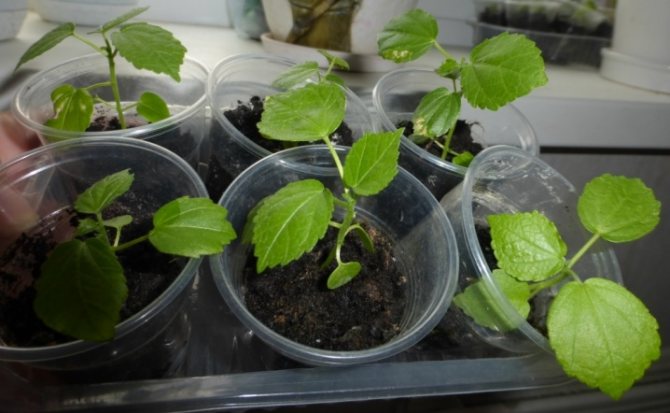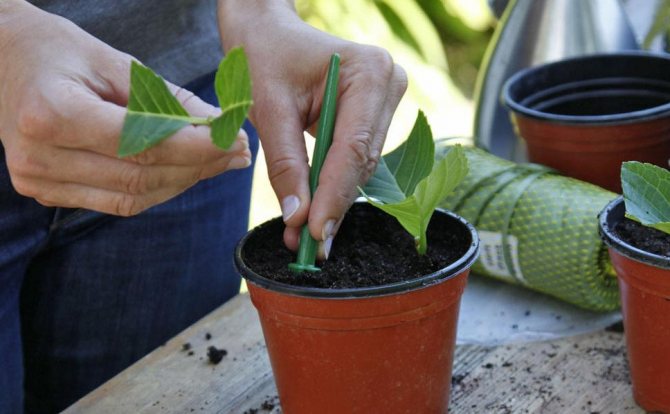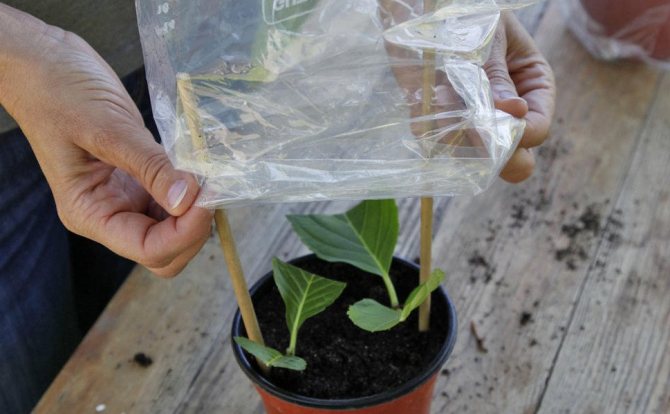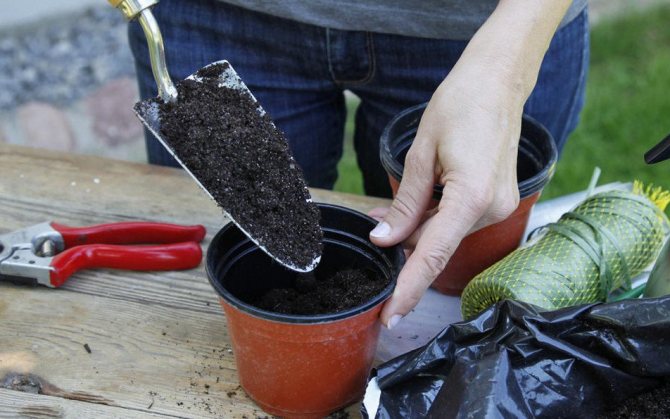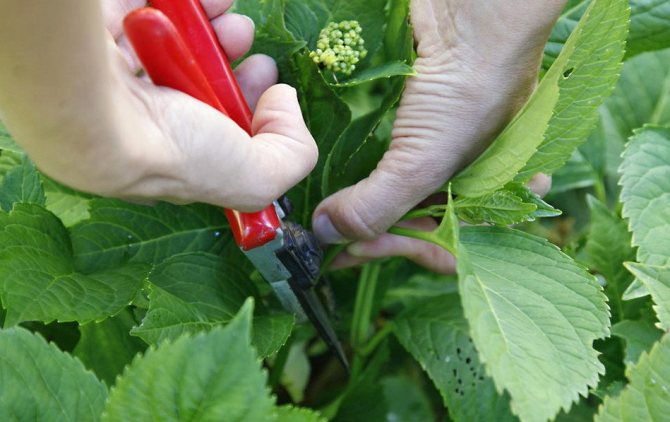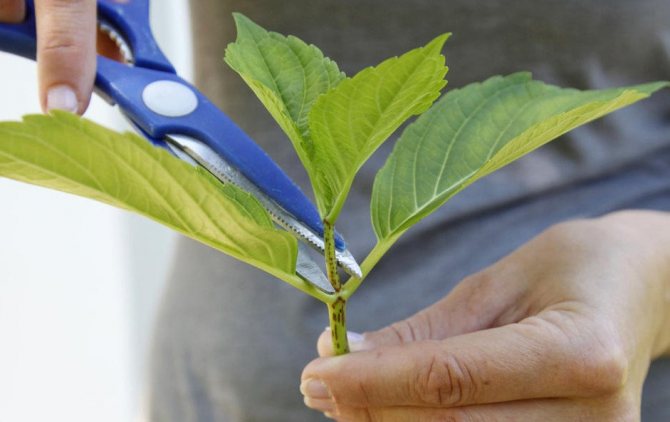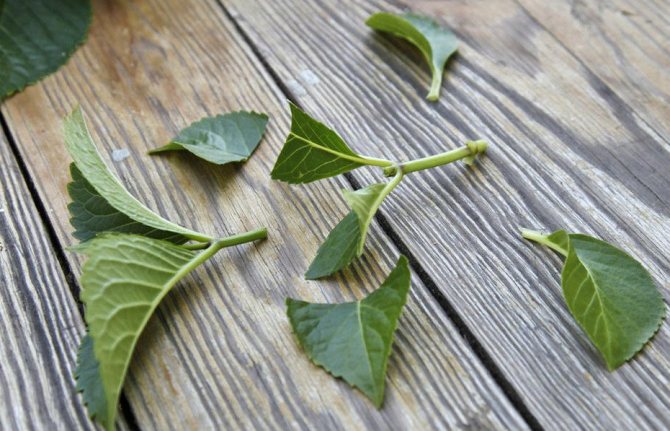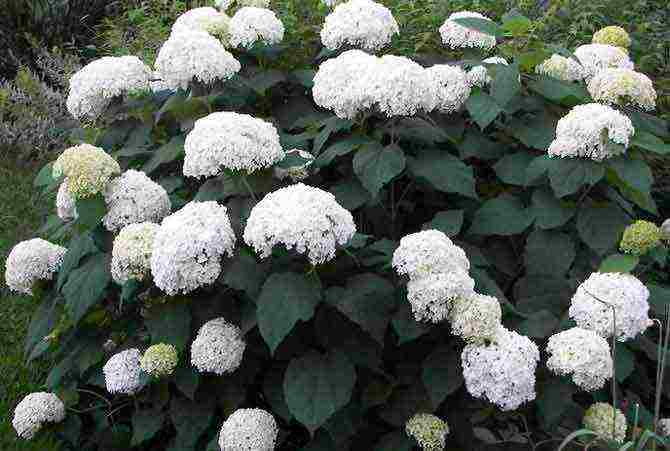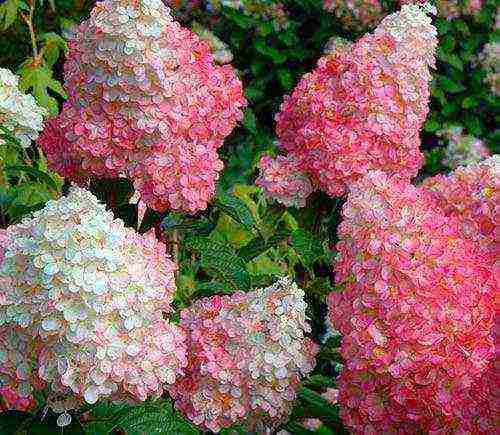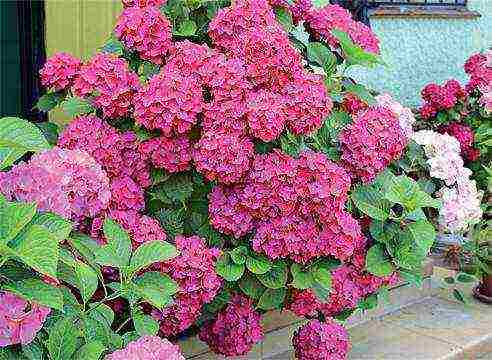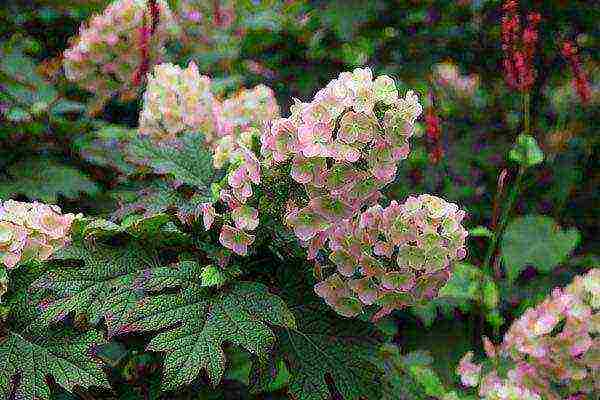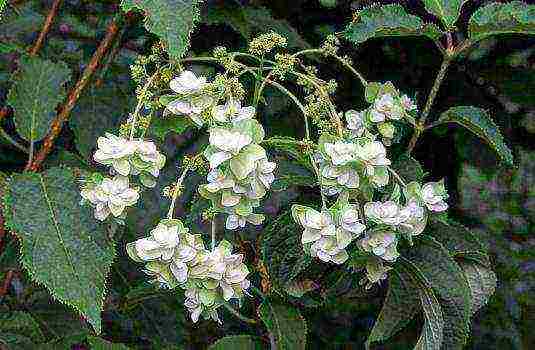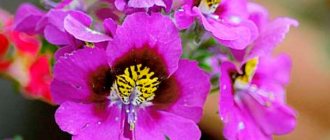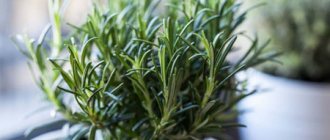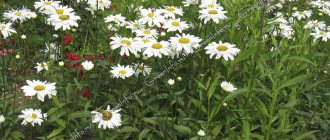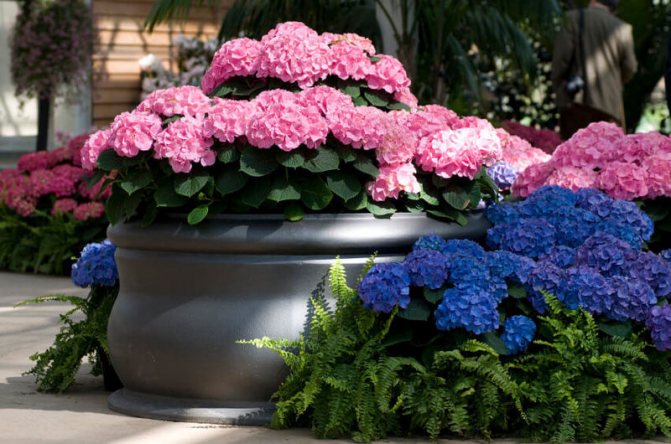
To create a unique atmosphere at the summer cottage, hydrangea is the best fit. There are many varieties of this plant, and most of them are quite cold-resistant and not too demanding on growing conditions, which makes it possible to confidently plant flowers beyond the Urals.
We will tell you how to grow hydrangea from seeds below.
Choosing hydrangea seeds for planting
Garden hydrangea is a flowering plant that is characterized by three methods of reproduction. If you do not have the opportunity to get cuttings or layering, then it can be grown from seeds.
When buying planting material, give preference to only trusted manufacturers. It is advisable to purchase grains that were brought from Japan or China. It is in these countries that the flower is found in natural habitat.
Before planting hydrangea seeds, you need to know how they look, otherwise you can run into a fake. High-quality planting material must meet the following requirements:
- the seeds must be whole, without any spots, marks or damage;
- not to have traces of the disease, not to be frozen and lethargic.
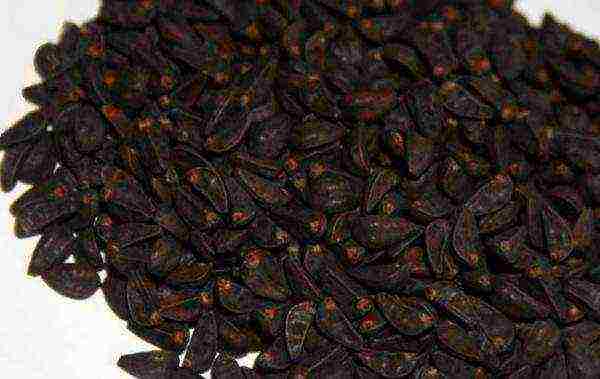

The hydrangea seeds themselves are dark brown in color, very small in size and oblong in shape. Do not forget to ask the seller if the grains meet the varietal characteristics. For growing on the territory of Russia, such varieties of hydrangeas as Macrophila, Paniculata, Trebovidnaya and Pereshkovaya are perfect.
Hydrangea from seeds can be easily grown at home. This is a fairly effective method that flower growers often use. Next, we will tell you how to plant hydrangea in open ground and special boxes at home.
Collection, storage and selection of seed
When growing hydrangeas in this way, gardeners use both store planting material and seeds collected by their own hands. Seed collection is carried out at the end of the season before the onset of frost. Collect planting material in dry weather. Prior to sowing, seeds are stored in a dry, well-ventilated, dark and cool room. During the entire storage period, the room maintains a stable temperature at the level of + 10 ... + 15 ° C with an air humidity of no more than 50%. To store the planting material, use bags of thick paper or bags made of natural fabrics.
Ripe hydrangea seeds, suitable for germination, are small in size, embossed surface, dark brown or brown-black in color. Light color of seeds indicates insufficient maturity. For germination, it is not recommended to use too old, moldy, frozen, rotten or damaged seeds.
The germination rate of such planting material, as well as the probability of obtaining healthy viable seedlings from it, is extremely low.
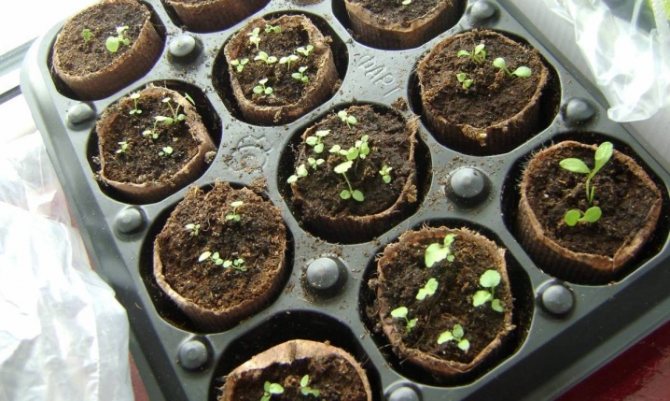

Many gardeners use store-bought planting material brought from China and Japan to grow hydrangeas in the described way. Observations show that the use of such seeds often gives very good results.In these countries, hydrangeas grow in natural, most favorable conditions, so their seeds have time to fully ripen by the time of harvest and accumulate a maximum of nutrients necessary for germination.
When choosing seeds of hydrangeas for further germination, it is necessary to study in detail the description of the variety you like. Attention should be paid to such important characteristics of the plant as winter hardiness and frost resistance. In many respects, the survival rate and success of adaptation of young seedlings in a new place after transplanting into open ground will depend on these qualities. Experienced gardeners, when choosing hydrangea seeds, recommend giving preference to the products of reputable agricultural companies. When buying planting material from sellers with a dubious reputation, the risk of failure increases significantly.
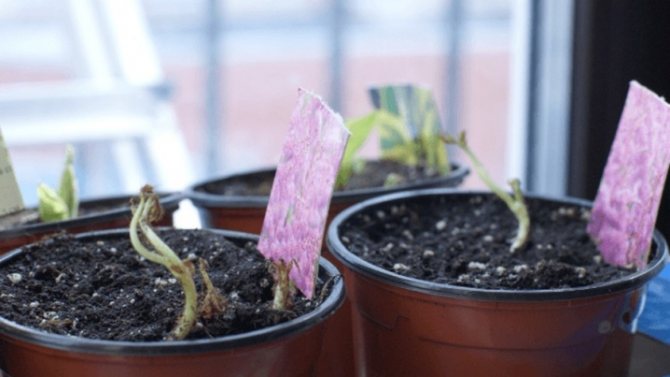

Planting seeds in open ground
Before sowing, you need to choose a suitable planting site and prepare it. Hydrangea loves cool and shady places. It should not be placed in direct sun, otherwise it will burn and hurt.
In open ground, seeds should be planted in late April - early May. The landing instructions are as follows:
- Dig up the ground, remove all vegetation and weeds.
- Fertilize the soil with peat, humus, or compost.
- Form a tall bed and carefully level the soil with a rake.
- Next, scatter the seeds in a chaotic manner and lightly press down with your finger. No need to bury.
- Sprinkle the sowing site with sand, which will act as a drainage.
- Spray gently on top with a little water.
The first shoots of hydrangea will sprout in a month. During this time, make sure that there are no weeds, water and feed. In case of frost, cover the seeds with paper.
Protection against diseases and pests
Hydrangeas rarely get sick, while the lion's share of the disease is transferred with seedlings. For this reason, you only need to buy new plants from proven nurseries. Other causes of diseases are called plantings thickening, lack of nutrients and high air humidity.
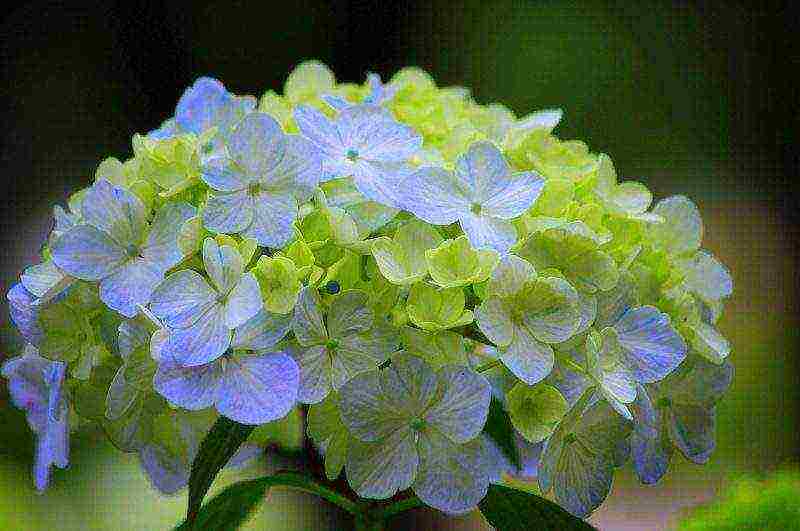

Many fungal diseases can be fought with copper oxychloride.
One of the most common diseases is chlorosis. Due to the lack of iron, the leaves turn yellow, while the veins remain green. For treatment, drugs Agricol, Brexil are used. As a preventive measure, plants need to be fed with iron-containing fertilizers in a timely manner.
Planting seeds in boxes at home
This is a more time consuming method of growing hydrangeas from seed. You can sow in containers already in winter. The landing stages are as follows:
- The seeds must be germinated before planting. Put tousled cotton wool in a low saucer, carefully lay out the seeds and cover with a second layer of cotton wool. Pour in a small amount of boiled water and leave for a couple of days. If mucus or an unpleasant odor suddenly appears, rinse the grains under running water and soak again. As soon as the seed swells or a root appears, you can start planting.
- The soil for planting should contain sand, leafy earth, sod land, humus and peat in a ratio of 12: 1: 1: 1: 12. If you do not have such components, then collect from the mole or dig up forest soil. Wooden boxes are ideal for planting.
- When everything is ready, sow the seeds in prepared boxes with soil mixture, press down a little, sprinkle with water and cover with foil or glass. Try to keep the temperature at 14-20 degrees. So the seeds will give good germination.
- The film should be removed when the first shoots appear. Before that, periodically ventilate the ground and monitor the moisture content of the soil.
The laboriousness of seed breeding in boxes is that hydrangea seedlings must be dived 2 times.This procedure consists in transplanting seedlings into separate pots or large containers at a great distance from each other.
The first dive is performed in the phase of cotyledonous leaves. The second pick takes place in May, when sunny and warm weather sets in.
Plant pots should be taken outside during the day to temper them. Make sure that there are no drafts and direct sunlight does not fall on young seedlings. Bring the pots home at night.
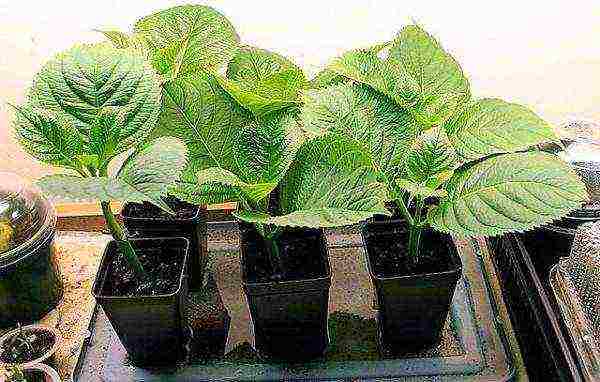

Seedlings obtained in this way should be grown in pots for 2 years. When the first buds appear, they must be cut off immediately so that the nutrients go to the roots and the plant takes root properly. Flowers in open ground can only be planted in the third year.
Instructions for planting seedlings in open ground
Hydrangea cuttings are planted both in early spring, even before the leaves bloom, and in autumn and summer. The distance between the bushes should be at least 1 m.You need to plant like this:
- Dig a shallow hole that is 2-3 times the diameter of the root system.
- Pour a fertile mixture at the bottom and mix it with the soil. Hydrangea potting soil, which contains an acidic top layer of peat, can be purchased at the store.
- Place the seedlings so that the roots are not above ground level. Cover with soil and tamp lightly.
- Water the bushes liberally and mulch the soil.
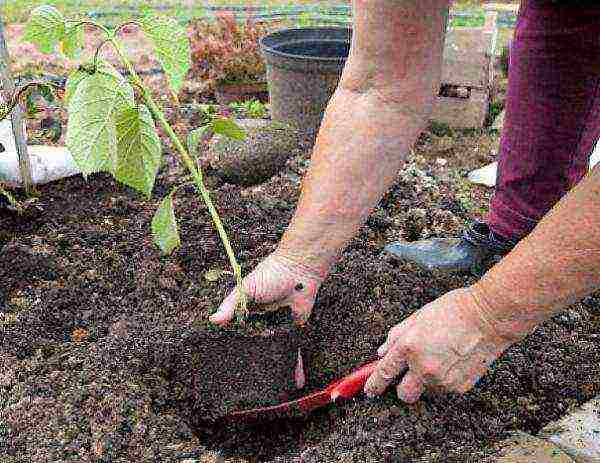

Other ways to propagate hydrangeas
Growing hydrangea from seeds is a laborious and time consuming way. It suits those who have a serious interest in the matter and enough patience.
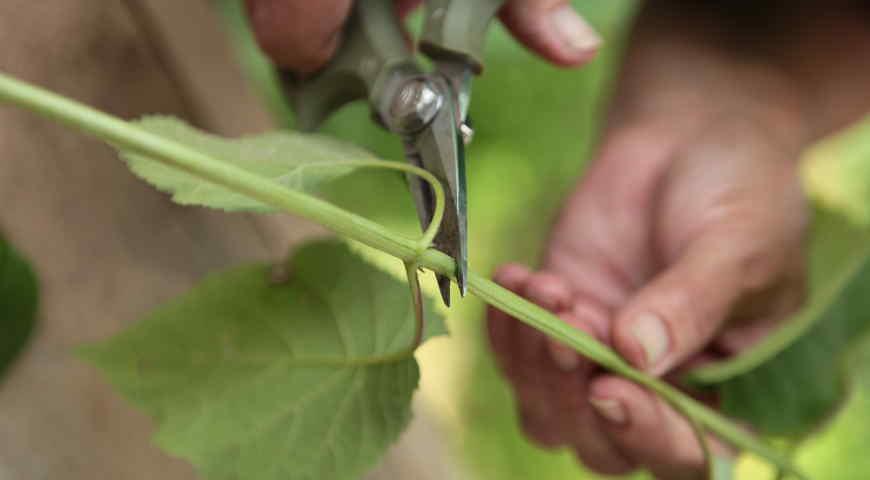

Hydrangea cuttings
For faster and easier reproduction, there are vegetative methods:
- The easiest way to propagate hydrangea is green cuttings, the percentage of their rooting is close to 100. To do this, in April-June, you need to choose annual shoots from the crown, cut cuttings from them, 10-12 cm long with 2-3 pairs of leaves. The cut is made at right angles. The leaves from the bottom must be removed, treated with root growth stimulants. When planting, you need to deepen the lower pair of buds to the middle of the internode. Cuttings take root in an average of 20-30 days. All this time, you need to maintain sufficient humidity. It is better to grow a seedling in a greenhouse with fertile soil or cover the planting with plastic bottles. The next year, plant the bushes in a permanent place.
- You can divide an adult bush in the spring. To do this, you need to dig it up, divide it with a pruner or a sharp shovel into several parts so that each one has several roots and shoots. The resulting cuttings are planted in a permanent place in fertile soil with an interval of 1 m. Usually, the divided plants take root well.
- Hydrangea is also propagated by layering. To do this, in the spring or autumn, choose a healthy bush, bent annual shoots to the ground, pin and dig in 2-3 cm.A top about 20 cm should remain on the surface.Periodically, you need to add soil and regularly water the layers and the bush. After a year, the shoot should take root. Then it is carefully separated from the mother bush with pruning shears and planted on the beds for growing. After another year, you can plant it in a permanent place. Young bushes will begin to bloom in the 4th year of life.
Growing a hydrangea is not an easy task in floriculture. But there is nothing supernatural either. You just need to plant it in a place without drafts, on moderately acidic soil, regularly water, fertilize and prune. You also need a lot of patience and love for flowering plants. With the right care, hydrangea will grow healthy, lush and regal.
Hydrangea seedlings care
After planting, the seedlings need to be cared for. To grow a strong and flowering shrub, young plants need to be regularly fed, watered, weeded and treated against pests.
Hydrangea loves moisture very much, so always keep the soil moist. If the topsoil dries up, irrigate it immediately with water, otherwise the flower will wither. Be careful not to overgrow the plants. Watering should be done regularly, especially in hot and dry weather. If it rains, watering stops.
Another important component of hydrangea care is feeding. Fertilizers are applied until June. If your soil is fertile and rich, then you do not need to feed the flowers. In light and sandy soil, plants need to be fed in late winter or early spring.
To accelerate the growth of seedlings, you need to apply mineral and organic fertilizers to the soil. It is advisable not to add substances that contain nitrogen, since the winter hardiness of the plant may deteriorate.
After planting hydrangea seedlings, pruning must be done. Weak and damaged branches must be completely removed. This is done to form the main stems and give the hydrangea shrub a decorative shape.
With proper planting and proper care, hydrangeas are unlikely to be damaged by any diseases and pests. However, some precautions still need to be followed:
- avoid scorching sunlight;
- add fertilizing on time and using the correct technology;
- try to follow the watering regime;
- do not thicken, give the hydrangea freedom.


Finally, we will reveal one secret how to turn a shrub of the same color into an amazing pink-blue plant. in the spring add sulfate, aluminum salts or sulfur to the soil. To ensure a smooth transition of color, enrich the ground unevenly.
Garden hydrangea also reproduces well by seeds. There are 2 ways to plant them. In both cases, gorgeous shrubs can be grown. Subject to all the necessary rules for planting seeds, the plant will delight the eye with the splendor of its flowering all season. Huge inflorescences give a special charm to the garden.
Hydrangea belongs to the Hortensia family. The genus includes about 70 species of various shrubs, dwarf trees and lianas. Large-leaved hydrangea is cultivated in the southern and western regions of Russia. In the northern regions, these flowers can be found on window sills as a pot culture. Most often, the plant is grown by seed. Sprouted seedlings can only be transferred to open ground after 2 years.
How to make a hydrangea bloom quickly
Flowers form on last year's shoots. The buds are laid in late autumn. To admire the inflorescences every year, you should cover well both young seedlings and lignified bushes. In addition, it is necessary:
Protect hydrangea from frost. In early autumn, in the late afternoon, the bushes are covered with lutrasil so that it does not come into contact with the tops of the shoots.
Water the bushes abundantly in dry autumn. Before leaving for the winter, the plant must receive the maximum amount of moisture.
- Do not open bushes immediately after snow melts. Geotextiles are removed as soon as the risk of frost disappears.
- Do not skip top dressing. The hydrangea must take whatever it takes to bloom next season.
- Do not cut off young bushes. You can shape and remove dried inflorescences as soon as the hydrangea is 3 years old.
The path from seed to flowering perennial takes about five years on average. In an apartment, the plant will bloom much earlier.
While watching the video, you will learn about growing hydrangeas.
This is not to say that growing hydrangeas from seeds is a troublesome business. The range of varieties that the stores offer are pleasing to the eye, and the hydrangea itself is undemanding to the conditions of detention. All that is required from the gardener is patience and time.
Have you noticed a mistake? Select it and press Ctrl + Enter to tell us.
Flowers and flowerbeds
Planting garden hydrangeas and care have their own characteristics.To admire the beautiful and lush flowering, we will learn how to properly care for this plant.
Preparing seeds for planting
Lat. Hydrángea
The large-leaved hydrangea varieties are better propagated by the seed method. This is a shrub that grows up to four meters under appropriate conditions.
The color of its flowers can vary from blue to pink. Large-leaved hydrangea is common in the southern and western parts of Russia. In the north and east, it is grown as a pot culture. The seeds can be bought both in garden stores and online.
The highest germination rate is obtained from seed from Japan or China. These countries are the natural habitat of hydrangeas. You can collect seeds from fertile flowers. They are small and inconspicuous. Lush inflorescences are sterile, they do not form seeds.
The viable seeds are intact, there are no dents or other damage on them. If the ordered material is damp or does not match the color, then it is dried in the oven. The seed material of all tree-like perennials needs preliminary preparation.
It accelerates germination, improves the number of sprouts, and reduces the risk of diseases. For disinfection, the seeds are soaked in potassium permanganate or a solution of copper sulfate.
Choosing hydrangea seeds
It is believed that seeds from the eastern countries, where the hydrangea come from (China and Japan), germinate best. Cheap seeds can be found in online stores that work directly with Chinese suppliers. The parcel is sent by post cash on delivery. However, consumer reviews suggest the opposite: it is better to trust Russian producers, despite the fact that seeds may cost a little more.
To determine a quality seed, you need to carefully look for damage. It should be intact, without dents. What hydrangea seeds look like: they are small, oblong, dark brown. If they are of a different color, they may be damp. You can collect the seeds yourself. They are formed only on fertile (small, nondescript) flowers. Bright large flowers serve to attract insects, they do not form pollen.
Additional Information. In the northern regions of Russia, hydrangea can be grown indoors. To do this, you should choose the Broad-leaved hydrangea (aka Large-leaved). It grows in the house for about 5 years, after which the plant is replaced with a younger one.
Planting seeds and growing seedlings indoors
The seeds are planted in February. Before planting, they are germinated. The material is placed on damp cotton wool or gauze, and after swelling, they begin to work. To prepare a nutritious substrate, you will need leafy earth, peat and sand in equal parts.
The container is filled with earth, and the seeds are laid out on top, without burying them. Sprinkle them on top with a layer of sand. The container is covered with glass or transparent film.
The seed is periodically moistened, but instead of a watering can, a spray bottle is used for irrigation. Excess moisture will lead to seed rot. The first shoots appear a few weeks after planting. Hydrangea can be planted in separate pots with the appearance of the second leaves. Caring for a plant is no different from caring for other indoor flowers. The pots are placed in a lighted place; direct sunlight should be avoided. The land is periodically loosened, often watered and complex fertilizers are applied.
Pruning hydrangeas in the fall
In order for the sprouts to quickly develop to the size of seedlings, they need to create a certain microclimate. Factors that affect the growth and development of young hydrangea:
- Bright diffused light. If the sun is not enough, then the delicate foliage will fade, and the plant itself will stop developing.
- Direct sunlight will cause burns. It is better to put the pots on the south window, after covering it with tulle.
- Heat.In the summertime, the thermometer should not drop below twenty degrees. For wintering, seedlings are sent to a dark, cool place.
- High air humidity. Young plants grown from seeds are regularly sprayed with a spray bottle. If there is no time for this, then you can put saucers of water next to the pots or use a humidifier.
- Fertilizers. During the growing season, feeding is applied 2 times a month. For hydrangeas, use Agricola, Iskra Zolotaya, Agrovita or a special fertilizer for azaleas, hydrangeas and rhododendrons. By autumn, the amount of dressings is reduced, and in winter they are not required.
- Soil acidity. Once a month, plants should be watered with slightly acidified water.
If these conditions are met, the seedlings grow strong and disease-resistant.
Growing seedlings
In order for the fragile seedlings of hydrangeas to quickly grow stronger and turn into full-fledged seedlings, they need to be provided with competent and delicate care. It includes the fulfillment of the following conditions:
- regular watering and soil moistening;
- optimal lighting;
- comfortable temperature conditions;
- top dressing;
- hardening;
- picks.
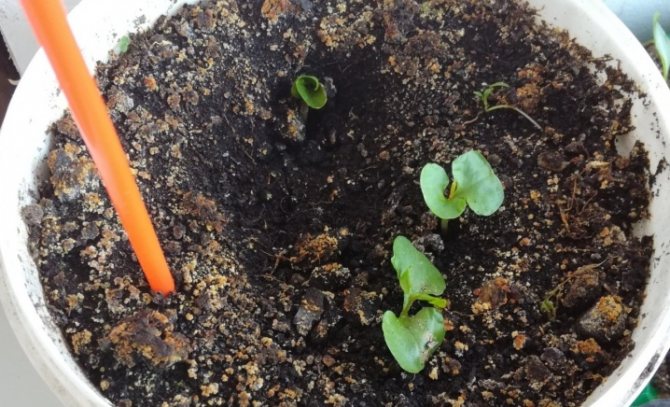

Watering and moisturizing
The soil in containers with hydrangea seedlings is regularly moistened, preventing the upper soil layer from drying out. Additionally, young plants are periodically sprayed with water from a spray bottle. Spraying will not only replenish the plants' need for moisture, but will also help maintain optimal air humidity. At the same time, water should not be allowed to stagnate in a container with sprouts. The excess water in the sump with seedlings must be drained after each watering. Seedlings are watered only with soft, settled water at room temperature. The best time to water is in the morning.
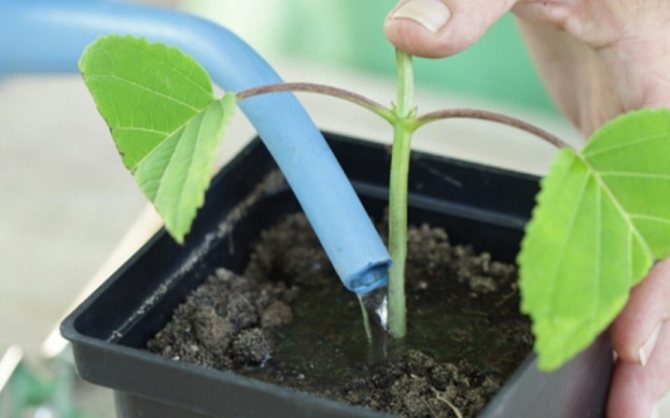

Lighting
Young hydrangeas require abundant, but soft and diffused lighting for full development and growth. Seedling containers are best placed on windowsills in the east, west, south-east or south-west of the house. It is not recommended to place boxes with seedlings of hydrangeas in places where the plants will be in direct sunlight for a significant part of the day. If the hydrangea bushes look weak, drooping or wilted at the end of the day, this may indicate that they are overheating. In this case, the seedling pots should be moved to light partial shade.
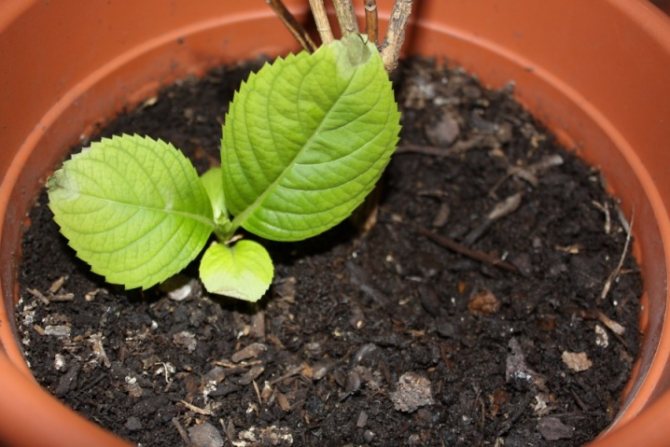

Temperature
Seedlings of hydrangeas, germinated from seeds, painfully tolerate changes in air temperature. In order for young plants to feel good, the air temperature in the room must be maintained at + 15 ... + 20 ° C. It is important to consider that a sharp drop in temperature for unhardened seedlings can be disastrous, as well as the effect of drafts. Both young hydrangea seedlings and adult plants should be protected from drafts.
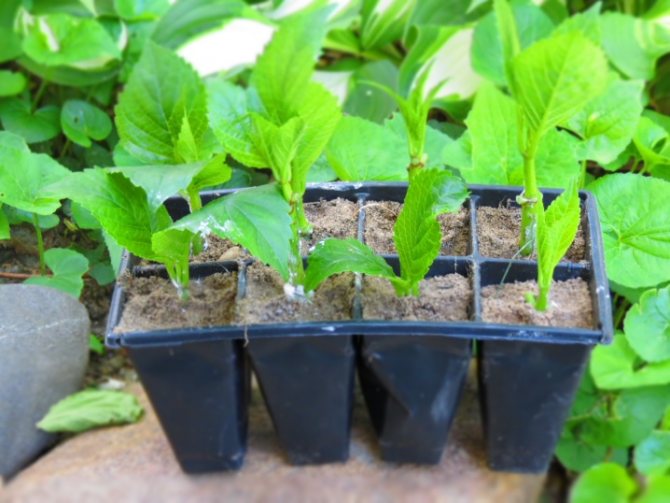

Top dressing
Before transplanting into open ground, it is recommended to periodically feed the seedlings of hydrangeas. Top dressing is carried out during the period of growth and development of green mass, using full complex fertilizers ("Aelita-Flower", "Fertika Lux", "For hydrangeas and rhododendrons" from Pokon). It is advisable to feed young plants 1-2 times a month.


Hardening
Before planting in open ground, hydrangea seedlings should be hardened. This procedure will increase the endurance of young plants, enhance their resistance to low temperatures. The hardening process is carried out gradually. To do this, containers with young plants are put out on the balcony for several hours every day. Over time, the duration of the stay of the seedlings on the balcony increases, removing it only for the night.
On warm, windless nights, containers with hardened hydrangea bushes are left on the balcony or taken out into the street.
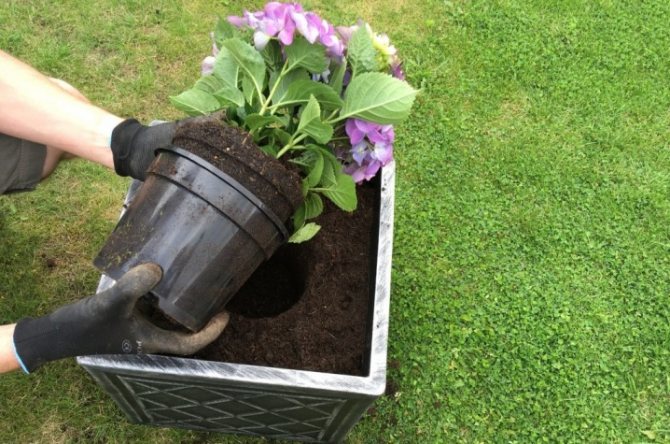

Picks
Growing hydrangea seedlings from seeds involves 2 picks.These procedures are necessary for the full development of young plants, active growth of their green mass and root growth. In the absence of picks, the seedlings will begin to stretch upward, weaken, oppress and shade each other.
The first pick is performed after the seedlings have 2 developed cotyledon leaves. At this stage, the plants are planted in containers at a distance of 10-12 centimeters from each other. The second pick is carried out at the end of spring. During this period, young bushes begin to actively build up green mass, requiring a sufficient amount of free space. At this stage, the seedlings of hydrangeas are planted in separate pots.
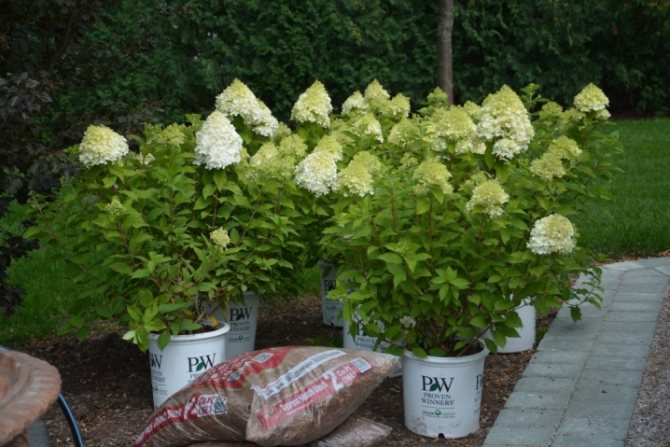

Choosing a place and soil in the garden
Hydrangea from seeds is planted in open ground two years after germination. This time is enough for the plant to fully acclimatize. Correctly selected soil affects the development of seedlings and the shades of future inflorescences.
The main conditions are:
- acidity;
- nutritional value;
- water permeability;
- ease.
Blooming white hydrangea
The plant thrives best on slightly acidic soils. Before planting, the soil must not be deoxidized, that is, lime must be added.
Soil with a low pH level is spilled with a citric acid solution. 10 liters of water requires a teaspoon of acid. Sour high-moor peat is added to the planting pit. Some fertilizers affect acidity: ferrous sulfate, ammonium sulfate and potassium sulfate.
The planting hole is dug up, humus and superphosphate are added. Drainage from sand and gravel is poured to the bottom. The roots of young plants are covered with a mixture of black soil, sand and peat. Then a layer of earth around the hydrangea is mulched. The mulch retains the moisture that hydrangeas need so much.
The distance between seedlings should be at least one meter. The shrub loves diffused light. Under the scorching rays of the sun, tiny and nondescript flower stalks will form. The best option is the east side.
Hydrangeas grown from seeds need a lot of feeding. The first application is carried out in the spring, before the beginning of the growing season.
The next portion of fertilizer is applied during the bud formation period. In summer, seedlings and mature shrubs are fed every 14 days.
Garden hydrangea - species and varieties
There are many types and varieties of this ornamental shrub. Most of them prefer to grow in partial shade, but there are some that do well in sunny areas. The height of the bushes and the flowering period are very different and depend on the variety.


The most common types:
- Large-leaved. It blooms in the second half of summer with lush inflorescences in the form of balls. Flowers can have different shades. Height - 2 m.Requires shelter in winter, maximum tolerates temperatures up to - 10 ° C
- Pereshkovaya. Variety of creepers. It blooms with white-pink inflorescences. Requires support, otherwise it will creep along the ground. A good option for arbors and arches.
- Tree-like. The flowers are snow-white. Height - up to 3 m. It looks very impressive, but freezes in winter. The plus is that the plant recovers quickly. Requires strong spring pruning.
- Paniculata. It blooms from July to late autumn with dense panicles 30 cm long. The shade of the inflorescences varies from white to greenish. The height of the bush is 3-4 m. An unpretentious and frost-resistant variety.
On the basis of these species, many different varieties have been created, each of which is beautiful in its own way. Depending on the type, hydrangeas can be deciduous or evergreen, but in our area they are most often grown in the first version.
Care
A young plant, which was recently a seed, requires special attention after planting in a permanent place.
The main factor affecting growth is abundant watering. The soil in the trunk circle must be constantly moistened. Periodically, the soil is loosened to retain moisture and oxygenate the soil.
Hydrangea decoration of the road area
To prevent seedlings from fungal and bacterial diseases, they are spilled with a weak solution of potassium permanganate.
The procedure is performed once a month. Mulch is required to protect the roots. Peat, bark and wood chips have worked well. The thickness of the mulch is 10 cm.
In order for the hydrangea to grow quickly, it needs nitrogen-potassium fertilizers at the beginning of the season. A tablespoon of urea and potassium sulfate is diluted in a bucket of water. One bush requires two liters of working solution.
Hydrangea blooms in the third year after planting. From this moment, the bushes begin to feed with slurry. Fertilizers are applied carefully: due to its excess, large inflorescences develop, which can break thin branches. With the onset of frost, young bushes bend down and sprinkle with earth. From above, the bush can be covered with lutrasil.
Description of culture
Hydrangea (Hydrángea) is a tree-like shrub from the Hortensia family. It was brought to Europe at the beginning of the 14th century from East Asia for the wealthy strata of the population. In the wild in Russia, it is found in the Far East. Today there are about 600 varieties of garden hydrangea. Mostly shrubs reach heights of 1 m or more. The bush is round in shape, the shoots are thin, slightly pubescent. The leaves are large, up to 20 cm long, the location on the shoot is opposite. Flowering lasts from July to autumn. Paniculate inflorescences, beautiful spherical shape.
Most varieties have two types of flowers:
- Fertile. They are small, located in the center, form pollen and fruits.
- Sterile. Large, attention-grabbing, unable to reproduce.
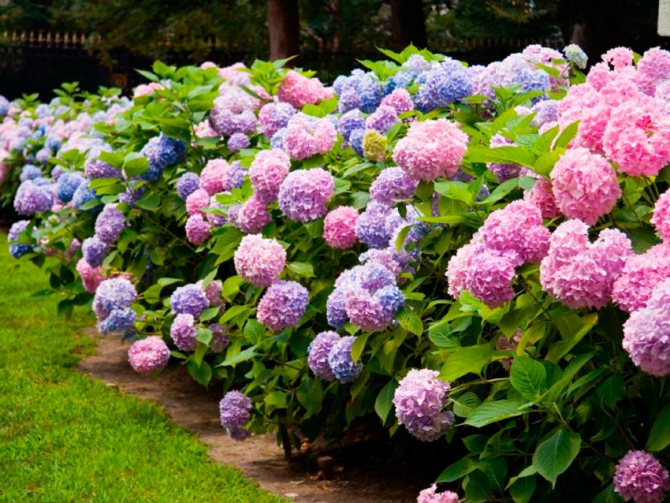

Growing hydrangea
There are varieties that have only sterile flowers. They do not produce seeds and reproduce only vegetatively. Some varieties need to be pruned annually, since the bushes are so elongated that they can break under the weight of the inflorescences. This extraordinary plant has varieties, the colors of which depend on the acidity of the soil: the higher the pH, the more intense blue the flowers will be. If you water the soil with a weak solution of potassium permanganate, then the flowers will acquire a pink tint for several days.
Interesting. The name of the plant comes from the word hortus - garden. In the era when it began to be grown as an ornamental, Hydrangea was a fairly common female name. There are even several versions after whom the shrub got its name. The Latin word "Hydrangea" means "a vessel of water". Perhaps the hydrangea got this name for its exactingness on soil moisture, or perhaps because its seed pods are like a jug.
How to care for a young plant?
The leaves of the plant are large, oval in shape. Garden culture blooms before the onset of frost. In spring, it forms flowers, the shade of which depends on the acidity of the soil. If the soil is neutral, the plant produces beige inflorescences. Lilac or pink flowers grow on alkaline soil. The acidic soil is saturated with aluminum, therefore it is unsuitable for growing hydrangeas. Horticultural crops form fruits - small boxes with seeds.
In Central Russia, the following types of hydrangeas are cultivated:
- garden;
- ground cover;
- tree-like;
- oak-leaved;
- serrated.
The botanical description indicates that hydrangea has low winter hardiness. It is necessary to cover it for the winter.
Periwinkle: planting and care in the open field, plant types
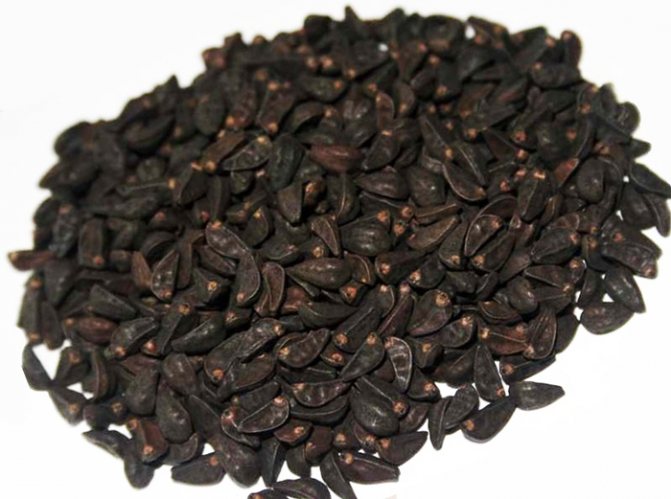

Panicle hydrangea Phantom: planting and care in the open field
Hydrangea care must be correct. The plant is pruned when it is three years old. Species blooming on last year's shoots are corrected in early spring, before bud break. Pruning must be done before sap flow, otherwise the plant will die. Adjustments should not be made too early.
Large-leaved crops need a rejuvenating haircut. Every fourth shoot should be removed annually. It is also necessary to remove dry leaves and branches.
To propagate a hydrangea by cuttings, you need to cut off the shoots. Pieces with 2-3 knots are obtained from them. The cuttings are planted in a container filled with a peat-sand mixture, deepened by 3 cm. After planting, water is added from a spray bottle. The soil with cuttings should be moist. When the planting material takes root, it will need to be planted in open ground.
For young sprouts, the optimum temperature is from 14 to 20 degrees. The lighting is diffused, intense.
The cleanliness of the crops should be maintained, weeds should be removed in a timely manner. Top dressing during this period is used only by special ones purchased from specialized companies.
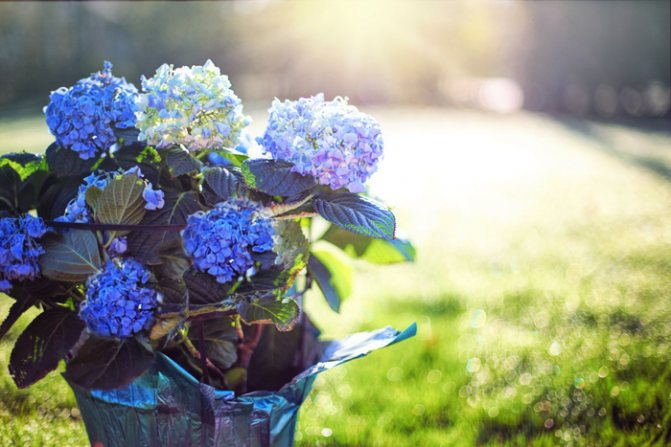

Hydrangea lives at home for 4-5 years. The plant is then replaced.
At home, a compact plant grows up to 1 meter in height, forms several flower balls with a diameter of 20-30 cm.
Growing a capricious flower requires strict adherence to the rules of care. Blue, pink white showy flowers of an adult hydrangea are a generous reward for attention and reverent care.
Some varieties of hydrangeas reach 2-4 m in height, and the growth of lianas sometimes exceeds 30 m. Deciduous shrubs are mainly cultivated, but there are also evergreen varieties. The leaves of the plants are large, oval in shape, with sharp teeth at the edges.
The color range of inflorescences is presented in white, pink, lilac, blue, red, beige shades. The blue color is obtained due to the property of hydrangea to accumulate in itself aluminum, which it takes from the soil.
| View | Description |
| Tree-like
| Bushes grow from 1 to 3 meters in height. At the beginning of the season, the flowers are green, then turn white. Inflorescences in the form of a ball. The shoots are annual, new branches grow every year. This species is also called "White Globe" and is widespread in gardens and parks. |
| Paniculata
| Single-stemmed and multi-stemmed trees grow up to 5 meters in height. Flowers are collected in paniculate inflorescences, similar to lilac flowers. A perennial plant lives for about 40 years. Abundant flowering begins in June, the buds fully open at the end of summer. At first they are greenish in color, in September they turn pink, then brick-colored and green again. The bushes are frost resistant. Main varieties: Tardiva, Kuishu, Grandiflora. The variety Sugar Dreams looks spectacular. It has a lush crown, oval leaves up to 13 cm in length. Inflorescences are pyramidal, panicles grow up to 25 cm in height. Sterile white flowers (2.5 cm in diameter) turn pink over time. The first flowers appear in the 4th year after planting. Bloom lasts from June to October |
| Large-leaved, or garden
| Bushes of large-leaved hydrangea are grown in garden plots, compact varieties are "lodged" on terraces, grown on windowsills and balconies. Herbaceous shoots, so the flower does not tolerate frosts. The leaves are bright green, large. Garden hydrangea blooms on last year's shoots. The shape of the inflorescences is hemispherical, umbellate. The color depends on the soil: the lilac color is obtained on neutral soil, and the blue color is obtained on acidic soil. Popular varieties: Renata Steiger, Expression, Romance |
| Dubolistnaya
| The species does not tolerate frost well and requires insulation for the winter. This variety has not only beautiful inflorescences, but also an unusual leaf shape. The height of the bushes reaches 2 meters. Inflorescences are large, 10-30 cm in diameter, bloom in mid-summer, white flowers turn pink by autumn |
| Ground cover, or variegated
| Frost-resistant perennial, grows up to 3 meters. Inflorescences are corymbose, by the end of flowering they are pink in color. Blooms from early July to autumn |
Hydrangea breeding methods at home
Use in landscape design
Hydrangea looks great both in single plantings and in group plantings.You just need to design in advance its location at a decent distance from other plants. Over time, the bushes grow strongly and require a lot of space.
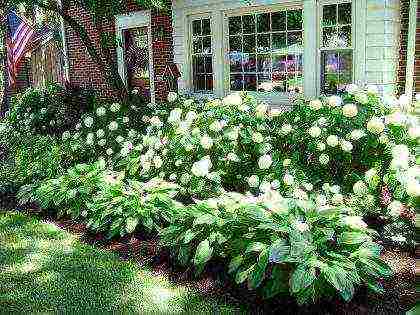

The flower can be planted as a soloist in the front garden if it is located on the north side of the house. When choosing hydrangea companions in a mixborder, you need to take into account their features. Similar requirements for moisture, lighting and soil acidity in astilbe, hosts, cuffs. If the site is large, you can plant a composition of several bushes. Their sprawling shape will create an expressive accent in the garden. These shrubs are often used to restrict areas of the garden.
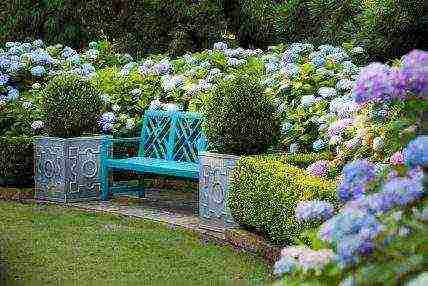

Hydrangeas work well with a variety of garden styles, so they can be grown by anyone.
The hydrangea plant belongs to the Hortensia family. It grows in the form of a liana or a compact tree. Hydrangea is widespread in Europe, Asia, China. The most popular type is garden hydrangea. It is a shrub that grows up to 2 m in height. Some summer residents prefer to grow vines. Hydrangea includes evergreen and deciduous species. In the conditions of central Russia, deciduous are cultivated.
Popular varieties
Despite the fact that hydrangea has several dozen varieties, not all of them take root in domestic latitudes. Plants can suffer from severe heat or frost, so for growing in a garden it is better to choose certain varieties that adapt well to difficult conditions.
Table 1. The most popular varieties of hydrangea that are suitable for growing in the garden.
| Variety of hydrangea | Description |
| Large-leaved | The most common garden variety, the height is about 2 m, the leaves are oval, flowers of white, pinkish or lilac shades are collected in large balls. A heat-loving variety that does not tolerate frost |
| Paniculata | It is a bush 2-5 m in height or a small tree growing up to 10 m. Flowers have a light green or white tint, collected in small panicles. A durable and unpretentious variety that can grow in any conditions |
| Bretschneider | A compact bush up to 3 m in height, the flowers are collected in umbrellas 15 cm in diameter, the shade of the petals is bright white, and towards the end of flowering it changes to red or purple. Leaves are dense green, ovoid in shape |
| Pereshkovaya | The variety has the form of a liana, which can grow up to 25 m, it braids decorative structures well, and in the absence of support it spreads along the ground. Inflorescences are white or pale pink, collected in small brushes, tend to fall off quickly |
| Ash (gray) | The shrub grows up to 2 m high and is most often used as a hedge. It blooms until the end of autumn, the inflorescences are small, in the form of small brushes, the leaves are elongated, dull green |
| Tree-like | A variety of hydrangea in the form of a small shrub, has a large number of varieties, grows on average up to 3 m, fluffy flowers, collected in balloons. The variety is resistant to frost |
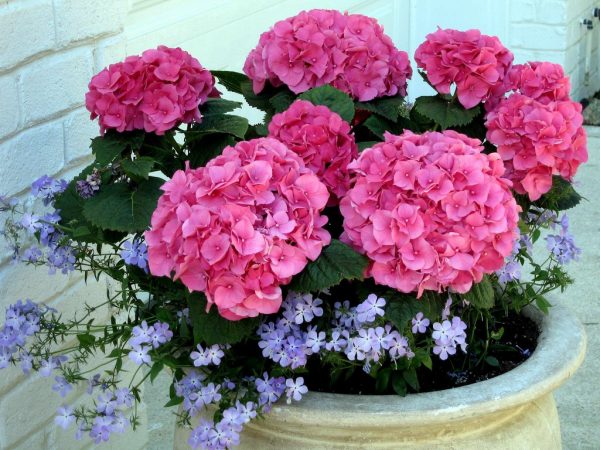

Hydrangea can be grown in a garden or decorative containers
For reference! The large-leaved crop variety has the most varieties - this type of plant can be grown both outdoors and as a houseplant.
Transfer
Young plants are transplanted annually after the end of the flowering period, and already rooted ones - after 2 years. In this case, the transshipment method is used, when a clod of earth is preserved near the roots. With this method, the plant tolerates the transplanting process much easier. The new pot should be one third or half the size of the previous one. Given the horizontal placement of hydrangea roots, wide, but low pots should be preferred. The top of the root should be level with the soil surface.
Hydrangea flowers will be white, red, or pink when the soil is low acid, and blue or blue when the soil is high.
The main pests and ways to control them
With proper care and compliance with agrotechnical requirements, the cultivation of hydrangeas can do without diseases and pests.
But such troubles can happen:
Powdery mildew
- this fungus appears at very high humidity, temperatures above 20 ° C and in the absence of sufficient sunlight. To combat it, use a solution of soapy water and copper sulfate (150 g of soap and 15 g of sulfate per bucket of water).
Ring spot of hydrangeas
- spots appear on the leaves, from which it begins to deteriorate. Also, the plant loses its ability to bloom. This disease cannot be cured, so monitor the quality of the seedlings very closely.
Spider mite
may appear in dry weather. With a small lesion, they are not as noticeable as with a large one. To get rid of it in care, they use such acaracides as thiophos, Fitoverm, Vermitic preparations. Soap treatment can also help.
They bring great harm to hydrangeas snails
that eat buds and leaves. You can fight them by removing them from the stems (like Colorado beetles) or you can use pesticides such as metaldehyde or "Thunderstorm".
To avoid diseases and pests, observe the following agrotechnical requirements:
1) avoid bright, scorching sunlight;
2) observe the irrigation regime, avoiding drying out or waterlogging of the soil;
3) apply top dressing in a timely manner and using the correct technology. Don't burn the plant;
4) do not allow thickening of the landings. Give your plants freedom.
Subject to all these necessary conditions for growing hydrangeas, it will delight you with the splendor of its flowering all season. After all, the huge inflorescences of hydrangea give it such a special charm that is difficult to resist.
Hydrangea bushes are deservedly considered one of the best options for decorating a garden. Lush inflorescences of various shades are difficult to miss against the background of foliage. I want to admire such beauty again and again. If you want to rejoice at the sophistication of a new variety, but there is nowhere to take a stalk, then you should learn how to grow hydrangeas from seeds at home, and transplant the seedlings into open ground.
Hydrangea seeds are small, oblong, dark brown grains. They do not look as attractive as the inflorescences, but the result is amazing. In the proposed photo, they can be seen on thin petioles located inside the inflorescence. After sowing, stunning flowering shrubs grow from several grown seedlings in a couple of years.
Signs of quality planting material:
- no stains, traces of mold and damage;
- the collection should not be frozen, sluggish and damp;
- corresponds to varietal characteristics.
You can collect it yourself at the end of the season, store it in a dry place at room temperature. Some growers use planting material from China and Japan, because it is there that hydrangea grows in natural conditions. Agrofirm Aelita offers customers a packaged collection of not only large-leaved, but also tree-like, paniculate, serrated and petiolate hydrangeas. On sale there are compact varieties with pyramidal and globular inflorescences, powerful shrubs with giant panicles. The manufacturer recommends sowing outdoors from April to early June.
Best of all, the garden method reproduces by seed, or behind which it is possible not only in the open field, but also at home. The main purpose of seed reproduction is precisely selection, but in the absence of cuttings, sowing can be successfully carried out. In colder regions, thermophilic species are grown as an indoor crop. The rules of maintenance coincide with the care on the site, only in winter the home hydrangea does not need shelter from the cold and snow.
How to prune and replant
Plant care cannot be imagined without pruning. This procedure is needed not only by the garden, but also by the indoor hydrangea. Moreover, it should be carried out twice a year:
- In the fall, to prepare for the rest period. Strong shoots need to be cut in half, and weak ones must be cut off completely.
- In the spring, overly stretched, weakened shoots are removed.
The next important procedure that is included in the care is transplantation. The hydrangea should be planted in a new location every year, using a slightly larger pot each time. It should be large enough to accommodate a horizontal root system. And in about 4 years it will need an update.
The most gentle way to minimize stress from the procedure is transshipment. Landing in this case is carried out together with a clod of earth. Drainage material must be placed on the bottom of the pot. Then lower the plant into the container, and then fill it with the prepared substrate. The level must correspond to the previous place. When planting is complete, it is recommended to cover the soil with peat mulch to prevent moisture from evaporating too quickly.
Transplanting mature seedlings to the site
Before planting hydrangea seedlings outside, you need to find a suitable place for them. It is recommended to choose a well-lit area with loose, light soil that contains sufficient nutrients. In terms of acidity, the soil should be slightly acidic. It is recommended to plant seedlings outside in May. Before that, the land on the plot selected in the garden is cleared of weeds and dug up with the addition of a small amount of peat.
Did you know? According to one version, the flower got its name in honor of the princess of the Roman Empire Hortense.
To fill the planting pits, a fertile substrate is prepared by mixing the following components in equal proportions:
- leafy earth or black soil;
- peat;
- sand.
Step-by-step instructions for transplanting hydrangea seedlings to the site:
- Dig planting holes 2–2.5 times larger than the size of the earthy clod around the roots (approximately 50 × 50 cm). The distance between adjacent plants should be 1–1.5 m.
- Place a drainage layer of pieces of broken brick or pebbles on the bottom of each depression. Pour some nutritious soil on top.
- Water the soil abundantly in the seedling pot. Remove the plant from the container along with the earthen clod.
- Lower the seedling into the planting hole, placing its root collar at the level of the soil surface. Sprinkle the roots with the rest of the soil mixture.
- Lightly compact the ground around the hydrangea. Water the seedling abundantly with warm water, saturating the soil with moisture to a depth of 30–40 cm.
- After absorbing moisture, cover the soil around the plant with sawdust or peat.
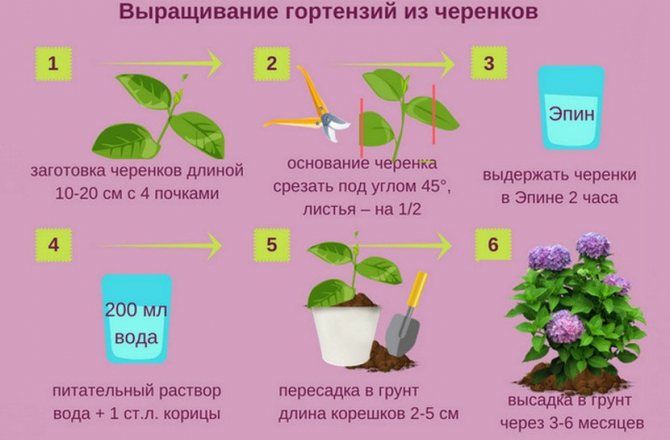

How to water
Caring for a plant at home includes several important procedures, none of which can be ignored. First of all, this is watering. Indoor hydrangea is very moisture-loving, as evidenced by its second name - "Hydrangea". It is translated as “a vessel with water”. Therefore, it must receive a sufficient amount of moisture. Especially plentiful watering is needed in hot weather; less water is required in spring and autumn. In winter, when the period of rest begins, it is generally symbolic.
Water for irrigation should be filtered or separated. You can freeze it, but before use it must thaw and warm to room temperature. Rainwater is only suitable if it is collected in an ecologically clean area. It is recommended to add a little lemon juice to the water for irrigation once a month (5 drops per liter are enough).
You also need to take into account that indoor hydrangea does not like dry air. The humidity in the room is needed quite high, you should not place pots with a plant near a radiator and other heating devices. Only in such conditions will it be able to develop normally.
Planting process
Now it's time to choose the soil. You can dig up and mix the following components in the correct proportions:
- peat;
- humus;
- sod, deciduous or coniferous soil;
- sand.
You can also buy ready-made land in the store. Keep in mind that hydrangea is a lover of acidic soil, like rhododendron. The ratio of the above components is 0.5: 1: 1: 1: 0.5.
The right place
Hortense does not like strong frosts, but prefers coolness. Direct sunlight is destructive for her, the leaves will hurt constantly. But if a warmer place is nevertheless chosen, take care of increasing watering. Protect the sprouts from the wind. Better to plant away from trees and bushes, otherwise they will take away all the water.
For the first time, they sow in containers, pots, then it is possible in open ground (but it is better not, because it is still cold in spring, and hydrangea does not like freezing).
In order not to wash off the seeds, watering should be carried out from a spray bottle.
In fact, the planting process itself is simple and clear:
- Already germinated seeds are simply placed on the soil, they do not need to be pressed, you can only cover them with sand for drainage, then they are covered with a film, which is removed after the seed has hatched.
- Next, you need to properly care.
In about a month there will be good sprouts, they must be planted in pots 7 cm wide. The soil must be mulched.
Photo
Photos of room hydrangea flowers, see below:
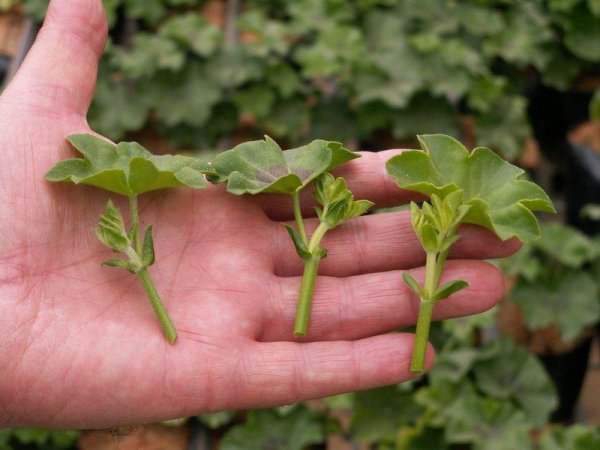

How to feed
So that the flower grows lush, and the flowering is plentiful, you cannot do without feeding. Nursing should be especially vigorous during the growth period. It is advisable to apply fertilizers every two weeks. For this, any complex fertilizers intended for flowering plants are suitable. They have been using them since the beginning of February. But during the winter dormant period, they are not needed.
A characteristic feature of hydrangea is that the color of its flowers can change if it is watered with different substances. For example, a solution of ammonium-potassium alum or salt will make its inflorescences blue. And lime added to the soil will give a pink or lilac hue. In this case, you can water half of the pot with one means, and the second with another, and as a result, get a multi-colored bush.
Suitable soil, temperature and lighting
Caring for a room hydrangea will require some effort, regardless of whether it is grown from seeds or cuttings. First you need to take care of the soil. You can either buy a suitable one in the store, or make your own mixture. It should include:
- 3 parts of sod land;
- 3 pieces of leafy land;
- 2 pieces of sand;
- 1 peat.
Next, you need to take care of the pot. You should choose it from a dense material, the best option is ceramic. The diameter should be about 9 cm. It is important that there is a hole in the bottom through which excess water will go.
Caring for the plant includes providing a suitable temperature and lighting. Indoor hydrangea feels good at a temperature of 18 - 22 degrees, so it is easy to grow it at home. Sudden changes in temperature should be avoided, and the pots should not be placed in a draft. In winter, the flower has a dormant period. At this time, he restores the resources that were spent on flowering. A suitable temperature for this time is about 7 degrees. If this is not followed, the plant may miss the flowering year. By the end of winter, buds will appear on it. This will serve as a sign that it is time to return it to a warmer room.
When choosing a place for a plant, you need to remember that indoor hydrangea does not like dark corners. But you should also not allow direct sunlight to fall on it. This can cause stains on the leaves. Optimal - the place is not very far from the window.

